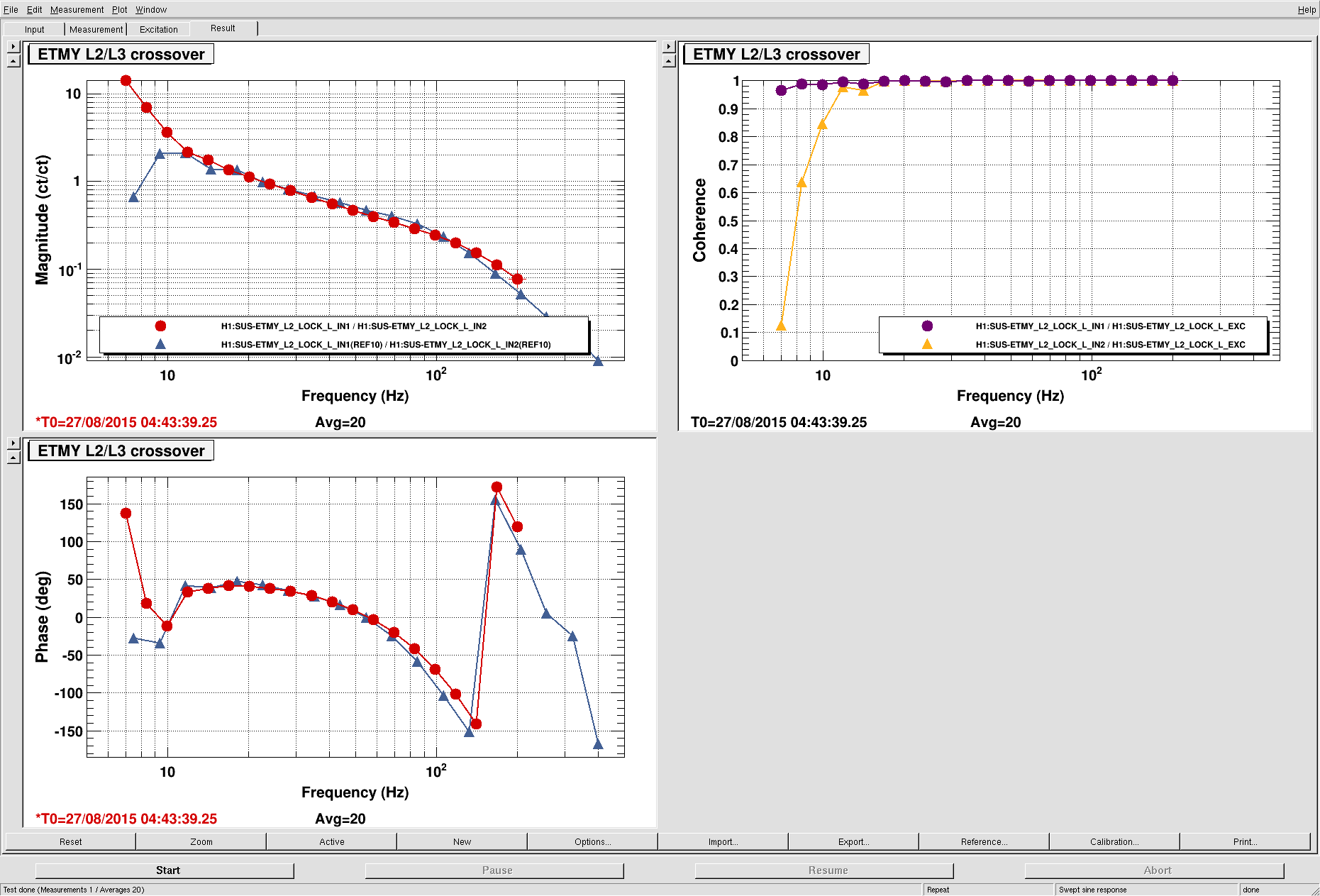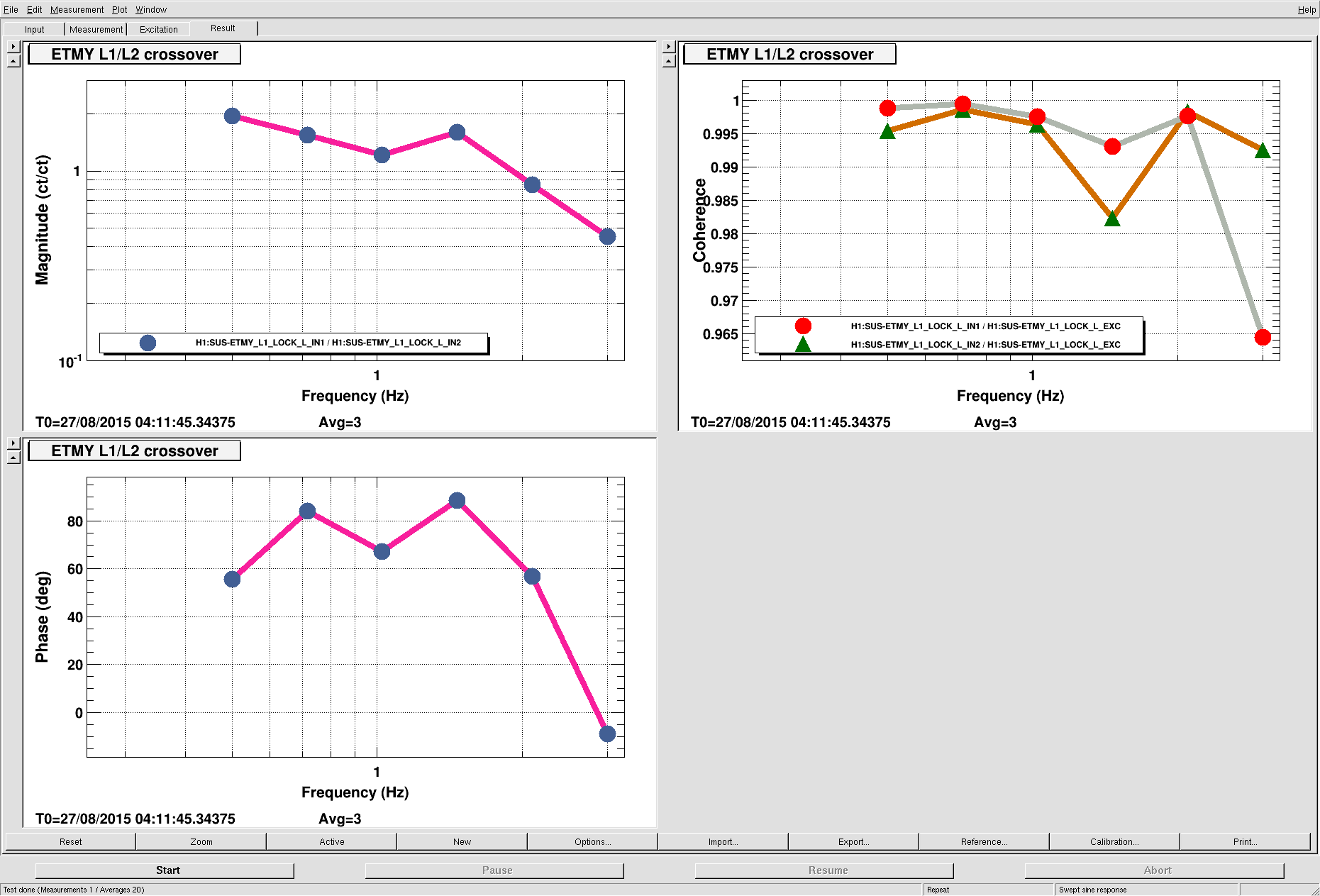J. Kissel, K. Izumi
Kiwamu and I have spent the day tuning measurements, and finally gathering all transfer functions that use the IFO to determine the overall scale factor of all stages of the ETMY actuator. To refresh your memory, that's using PCAL, ALS DIFF VCO / PLL, and Free Swining Michelson techniques. We tried following the prescription that Joe, Kiwamu and I had agreed upon (see T1500383), but we ran into a few flaws in our plan, and diverted accordingingly. However, I think we have everything we need to make estimates of the actuation strength of ETMY with these three methods, as has been done prior to ER7 (see LHO aLOG 18767). As with other measurements this week, analysis and results are to come, but we want to at least aLOG where the measurements live, and the details / gotchas of today's exercise so that we remember them in the future.
Details
------------
The list of measurements (and how they differ from T1500383):
PCAL:
optic [m] RXPD [ct] PCALY [m] IFO DARM [ct] ETMY L3 LV LPON EXC [ct] IFO DARM [ct]
--------------- = ---------- x ------------- x ------------------------- x ------------------------ x ---------------
iStage EXC [ct] PCALY [m] IFO DARM [ct] ETMY L3 LV LP ON EXC [ct] IFO DARM [ct] iStage EXC [ct]
(1) (2) (X) (X) (Y)
Measurement (1) we obtain, a priori, from the PCAL team. This is determined by their estimation of the power on the test mass (see, e.g. LHO aLOG 20459, and more completely in T1500252).
Measurement (2) is a PCAL to DARM transfer function (DARM_IN1 / RX_PD) using the pre-calibrationed (from (1)) RX_PD channel as the reference.
Measurements (X) and (Y) are lettered not numbered, because these same transfer functions are used for all three measurement techniques. However, these (Y) (and (X)) transfer functions are drives from the L3 / L2 / L1 TEST L filter banks at each stage, such that the exciations downstream of all LOCK and DRIVEALIGN heirarchy filter banks. Therefore we're only measuring the actuation strength of each stage (without the confusion of the hierarchical control filters). The response channel is DARM_IN1. Note that (X) is repeated twice in the PCAL method because we get an absolute [m / ct] calibration for the ETMY L3 EXC, which is then propogated to the PUM/L2 and UIM/L1 stages as well, which we do by using the ratio of (X) and (Y).
Measurements (2), (X), and (Y) are gathered with the IFO fully locked using all of ETMY in its lowest noise state.
ALS DIFF:
What we had planned to do, as shown in T1500383, was the following:
optic [m] f_green [Hz] L_arm [m] DIFF PLL [ct] ETMY HV L3 EXC IFO DARM [ct]
---------- = A_VCO x ------------- x ------------ x ------------------- x (1 + G_DIFF) x -------------- x ---------------
iStage EXC DIFF_PLL [ct] f_green [Hz] ETMY L3 HV EXC [ct] IFO DARM [ct] iStage EXC [ct]
(3) (4) (5) (6) (7) (Y)
However, we ended up doing a few of the measurements differently today, for two reasons:
(a) For (5), we had previously used ETMX L2 (see LHO aLOG 18711). We had used ETMX L2 because it was an out-of-loop excitation; ALS DIFF uses EX L3 and EX L1 to lock green, but it does not use the EX L2 stage. However, we were sad about the 1/f^4 roll-off of the L2 actuator -- it provided little coherence above the relatively noise ALS DIFF noise. Instead of using ETMX L2 EXC, one immediately suggest using ETMX L3 with the high-voltage driver, but we were worried about confusion with the loop hierarchy, so we though to go with ETMY L3 in its high voltage configuration -- that way we could similarly treat it as an out-of-loop excitation, we wouldn't have to worry about being confused by the hierarchy of the ETMX control, and we'd get the extra f^2 of actuation strength. HOWEVER we didn't think of this ahead of then, but it was implicitly assumed that we could lock the full IFO on ETMY with the driver in its HV stage in order to transfer the ALS DIFF absolute calibration of the ETMY L3 HV configuration to the ETMY L3 LVLN, LP ON configuration. We've *not* developed developed a stable configuration with the Full IFO locked with ETMY L3 HV, and even if we had it, we've not demonstrated that we can switch between HV and LV LP ON while the interferometer is locked. We figure commissioning such a thing was a huge adventure that we did not want to undertake.
(b) It turns out, with a little bit of ingenuity (a.k.a. Izumi-sensei wisdom), we can use the entire ETMX drive as a whole (i.e. the super-actuator of L3 and L1) in concert with the DIFF PLL CTRL signal that we've already calibrated to obtain the equivalent of (3) and (4). Take the ALS DIFF loop as follows, where excite just down stream of the DARM bank, such that you're still using the SUS in whatever hierarchy is predefined (we used the L3 LOCK bank):
+------+ +------+
-----| ETMX |----| DIFF |-------> DIFF_PLL_CTRL
| +------+ +------+ |
| |
IN2 <-| |
| +------+ |
+ ----< -1 |---| DARM |-------
^ +------+
|
L3 LOCK
EXC
It so follows that
L3 LOCK IN2 1
----------- = ----------
L3 LOCK EXC 1 + G_DIFF
which is true with any excitation at any point around the loop, just like is done "normally" done with a DARM IN2 / DARM EXC TF. Further,
DIFF_PLL_CTRL 1
------------- = ---------- x ETMX x DIFF
L3 LOCK EXC 1 + G_DIFF
one can immediately see that the absolute calibration of the super-actuator ETMX falls out of ratio of these two transfer functions, assuming you have the absolute calibration of DIFF such that you can divide it out (i.e. the [Hz/ct] and z:p = 40:1.6 Hz pair of the VCO, i.e. measurements (3) and (4), which we do, a priori). What's great, is that since you're using the same excitation, as long as you store both of these channels in the template, you can directly measure and export the transfer function ratio that you really want,
DIFF_PLL_CTRL
------------- = ETMX x DIFF
L3 LOCK IN2
and thus you've reduced two measurments, formerly (5) and (6) into one. So today's version of the ALS DIFF Equation is
optic [m] f_green [Hz] L_arm [m] DIFF PLL [ct] ETMX L3 LOCK EXC [ct] IFO DARM [ct]
---------- = A_VCO x ------------- x ------------ x ------------------- x --------------------- x ---------------
iStage EXC DIFF_PLL [ct] f_green [Hz] EX L3 LOCK IN2 [ct] IFO DARM [ct] iStage EXC [ct]
(3) (4) (5) (Z) (Y)
Measurement (3) is obtained by measuring the open loop gain of the ALS DIFF PLL independently, while locked to an independent frequency reference, instead of the beat-note from the DIFF PD, i.e. LHO aLOG 20850, LHO aLOG 20542, etc.
Measurement (4) is obtained by using the ALS DIFF PLL in the same way as (3), but sweeping the lock frequency of the frequency reference, i.e. LHO aLOG 20603.
Measurement (5) is as described above, driving EX L3 LOCK EXC while the IFO is only ALS DIFF locked, but measuring the transfer function EX L3 LOCK IN2 and DIFF_PLL_CTRL
Measurement (Z) is performed with the IFO in full low noise lock (locked on ETMY in its low-noise state). Note that the nominal lowest noise state is to have the ETMX driver turned OFF. With the driver ON (so you can take this measurement) the ESD DAC noise destroys the low frequency performance, so you have to drive pretty dang hard to get good coherence.
Measurement (Y) are as described above.
Free Swinging Michelson
Similarly to the ALS DIFF method, we planned (in T1500383) to propogate the Michelson absolute calibration down the Y-arm, instead of the X-arm like we had done previously (see LHO aLOG 18718), by driving ETMY using the high-voltage driver. For the same reasons as DIFF, propogating that absolute calibration to the LVLN LP ON configuration in full-lock would have been hard-to-impossible. As such, we performed measurements in exactly the same way we had done before, propogating down the X ARM, and relying on (Z) from the ALS DIFF technique,
optic [m] MICH [m] AS_Q [ct] ITMX L2 EXC [ct] SARM [ct] ETMX L3 LOCK EXC [ct] IFO DARM [ct]
----------- = ----------- x (1 + G_MICH) x ---------------- x ---------------- x --------------------- x --------------------- x --------------
iStage EXC AS_Q [ct] ITMX L2 EXC [ct] SARM [ct] ETMX L3 LOCK EXC [ct] IFO DARM [ct] iStage EXC [ct]
(6) (7) (8) (9) (10) (Z) (Y)
Measurement (6) is the "free-swinging" part of the free-swinging Michelson, where we fit the AS_Q and AS_DC signals to an ellipse to obtain the optical gain of the Michelson.
Measurement (7) is the open loop gain of the Michelson, taken with MICH locked using the BS, such that we can back out the loop suppression from the ITM excitation.
Measurement (8) is the ITM excitation, taken in the same MICH lock stretch as (2). Note that we made sure to put the ITM L2 stage in its highest range state (state 2) to get the best SNR.
Measurement (9) and (10) are taken with the XARM locked on red. The only difference this time is that we drove from the LOCK bank, again treating ETMX as a super-actuator, not caring about the individual strength of the test mass stage.
One last thing regarding all of these measurements. We had set a goal to get coherence out to 200 [Hz], but Kiwamu found on Monday that ALS DIFF measurement (5) was difficult to get
---------------------
The data / templates for the IFO measurements we took / tuned today have been committed to the CalSVN in the following locations:
(2) /ligo/svncommon/CalSVN/aligocalibration/trunk/Runs/ER8/H1/Measurements/FullIFOActuatorTFs/2015-08-26/
2015-08-26_H1SUSETMY_PCALYtoDARM_FullLock.xml
(5) /ligo/svncommon/CalSVN/aligocalibration/trunk/Runs/ER8/H1/Measurements/ALSDIFF/2015-08-26
2015-08-26_ALSDiff_ETMX_L3_HVHN.xml
(6) /ligo/svncommon/CalSVN/aligocalibration/trunk/Runs/ER8/H1/Measurements/FreeSwingMich/2015-08-26/
2015-08-26_H1MICH_freeswingingdata.xml
(7) /ligo/svncommon/CalSVN/aligocalibration/trunk/Runs/ER8/H1/Measurements/FreeSwingMich/2015-08-26/
2015-08-26_MICH_OLGTF.xml
(8) /ligo/svncommon/CalSVN/aligocalibration/trunk/Runs/ER8/H1/Measurements/FreeSwingMich/2015-08-26/
2015-08-26_H1SUSITMY_L2_State2_MICH.xml
(9) /ligo/svncommon/CalSVN/aligocalibration/trunk/Runs/ER8/H1/Measurements/FreeSwingMich/2015-08-26/
2015-08-26_H1SUSITMX_L2_State2_XARM.xml
(10) /ligo/svncommon/CalSVN/aligocalibration/trunk/Runs/ER8/H1/Measurements/FreeSwingMich/2015-08-26/
2015-08-26_H1SUSETMX_L3_HVHN_XARM.xml
(X) /ligo/svncommon/CalSVN/aligocalibration/trunk/Runs/ER8/H1/Measurements/FullIFOActuatorTFs/2015-08-26/
2015-08-26_H1SUSETMY_L3toDARM_LVLN_LPON_FullLock.xml
(Y) /ligo/svncommon/CalSVN/aligocalibration/trunk/Runs/ER8/H1/Measurements/FullIFOActuatorTFs/2015-08-26/
2015-08-26_H1SUSETMY_L1toDARM_FullLock.xml
2015-08-26_H1SUSETMY_L2toDARM_FullLock.xml
(Z) /ligo/svncommon/CalSVN/aligocalibration/trunk/Runs/ER8/H1/Measurements/FullIFOActuatorTFs/2015-08-26/
2015-08-26_H1SUSETMX_toDARM_FullLock.xml
For the record, even though T1500383 defines an order to take these measurements to minimize time to take these 11 measurements, we deviated from the plan so that we could spend time tuning up the TFs that we needed. As such, we took the ALS DIFF measurement (5) first, then brought the full IFO up, then took (2), (X), and (Y). Sadly, we lost lock from what likely was the consequences of two successive small earthquakes (5.2 and 4.9 in the mid-atlantic ridge). As such, we didn't get (Z) until we re-locked the IFO about an hour later. Once we got (Z), we intentionally broke the lock again to get (6) through (10). Because the IFO *may* have had a different optical gain between the first lock stretch where we got all of the Y arm measurements, and the other lock stretch when we got (Z) which is used to propogate the absolute calibrations from the FSM and ALS DIFF methods, there *may* be a systematic discrepancy between those two methods and the PCAL method, but we'll just have to wait for the analysis to find out. And we'll compare against another measurement suite that will be taken on this coming Friday.
























